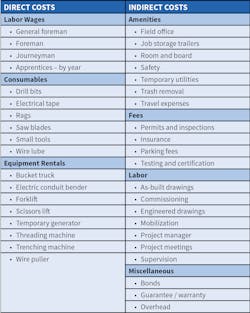Electrical contractors are sometimes asked to provide “labor-only” installations from a customer or potential customer. The idea is that the client will provide the materials/electrical equipment, and the contractor will provide the manpower. The client thinks the labor costs from the contractor are based on the hourly wages of the workers installing the materials. However, if you take on a project using this approach, you won’t be profitable.
In this situation, a contractor is confronted with two main challenges. First, projects are more than just direct labor. Second, you must place a reasonable profit margin on a project for the risk involved. A contractor is not a labor pool service, but rather a service provider to install electrical projects. The term “labor-only” minimizes a contractor’s value in providing quality service during the installation. And, depending upon the number of workers required, a contractor may need financing to meet payroll obligations before receiving timely payments from the owner.
Some people in the industry think that a labor-only estimate is simply an estimate of direct labor costs. But there really is no such thing as a labor-only contract. The contractor’s labor forces must be supervised, tools must be furnished, and equipment must be coordinated. The main reason is there are both direct and indirect labor costs on a project. There are also indirect material costs required for the installation of material and equipment.
Project costs are comprised of direct and indirect costs. These costs include both labor and material items. The Table lists the possible direct and indirect costs for a labor-only project. Of course, not every project will include all of these items, as the scope of work and type of project will determine these costs.
When submitting a price to install a project as per plans and specifications, the bid price must include all labor (direct and indirect), indirect material costs, and project-related equipment, which might include, but not be limited to, any of the following: threading machines, wire pulling equipment, trenching machine, forklift, etc.
When materials are ordered and delivered by someone other than the contractor, labor productivity can quickly be impeded. Depending on the size and complexity of the project, labor-only projects can pose the following material problems:
1. Difficulty in getting information for installation requirements.
2. Lack of someone with authority when dealing with owner’s vendors.
3. Lack of authority to deal directly with material and equipment suppliers.
4. Delayed material and equipment deliveries .
5. Receiving and checking materials as delivered.
6. Owner’s materials are stored offsite and must be picked-up.
7. Insufficient quantities on-site.
8. Incorrect materials ordered.
9. Uncoordinated deliveries (i.e., arriving at the end of the work day).
10. Owner-supplied equipment may require assembly unknown to the contractor.
11. Late delivery of shop drawings from the owner’s suppliers.
Remember that these problems create uncontrollable risks. If the specifications do not provide you with any direction related to these possible problems, seek clarification with the owner before submitting your proposal. Especially on larger projects, you may have to have a dedicated employee just to receive, verify, and store owner-furnished materials.
Poor material handling will affect all components of the labor, especially the installation time. Therefore, you must determine appropriate labor units that match the project conditions. Labor units will need to be adjusted to compensate for the risks involved.
A properly estimated project should give you the confidence in the selling price to the owner. When the bid is summarized, you must make allowances for the labor-only project. Before submitting your final price on this type of project, be sure that you have included any of the following:
• Enough labor hours (direct and indirect).
• Labor allowances for material related risks.
• All equipment costs.
• All fees and permits.
• Site-related amenities.
• Special insurances that may be required.
• All taxes and bonds.
• Overhead and profit.
The main concern when bidding a labor-only project is the amount of overhead percentage placed on the final bid price. The overhead percentage may need to increase on a labor-only project to ensure that the project yields a profit.
Before signing a contract with an owner for a labor-only contract, it would be wise to have a meeting with the client and explain the uncontrollable risks placed upon your company. When everyone involved in this type of project fully understands all the components involved, all parties can benefit. So always remember, identify the risks — and bid accordingly.
Kiper is an independent electrical estimating trainer and consultant based in Niagara Falls, N.Y. He can be reached at [email protected].
About the Author
Don Kiper
Independent Electrical Estimating Consultant
With more than 35 years of experience as a construction electrician, industrial maintenance electrician, foreman, estimator, estimating manager, and project manager, Don has used what he learned to lead in the implementation of estimating software with three electrical contractors where he has worked. Don has 17 years of experience in the construction field and 18 years of office experience and he has personally estimated over $700 million dollars in electrical projects.

